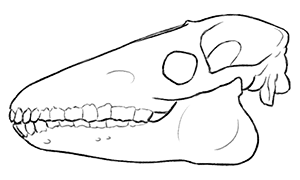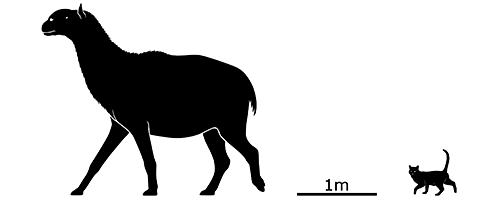It’s time for a little bit more recent PBS Eons work this week:
• The metatherian predator Arctodictis and the litoptern ungulate Thoatherium from “The Mystery of South America’s False Horses”
Paleontology and science illustration, and feathering ALL the dinosaurs
It’s time for a little bit more recent PBS Eons work this week:
• The metatherian predator Arctodictis and the litoptern ungulate Thoatherium from “The Mystery of South America’s False Horses”
Neolicaphrium recens here might look like some sort of early horse, but this little mammal was actually something else entirely.
Known from southern South America during the late Pleistocene to early Holocene, between about 1 million and 11,000 years ago, Neolicaphrium was the last known member of the proterotheriids, a group of South American native ungulates that were only very distantly related to horses, tapirs, and rhinos. Instead these animals evolved their remarkably horse-like body plan completely independently, adapting for high-speed running with a single weight-bearing hoof on each foot.
Neolicaphrium was a mid-sized proterotheriid, standing around 45cm tall at the shoulder (~1’6″), and unlike some of its more specialized relatives it still had two small vestigial toes on each foot along with its main hoof. Tooth microwear studies suggest it had a browsing diet, mainly feeding on soft leaves, stems, and buds in its savannah woodland habitat.
It was one of the few South American native ungulates to survive through the Great American Biotic Interchange, when the formation of the Isthmus of Panama allowed North and South American animals to disperse into each other’s native ranges. While many of its relatives had already gone extinct in the wake of the massive ecological changes this caused, Neolicaphrium seems to have been enough of a generalist to hold on, living alongside a fairly modern-looking selection of northern immigrant mammals such as deer, peccaries, tapirs, foxes, jaguars… and also actual horses.
Some of the earliest human inhabitants of South America would have seen Neolicaphirum alive before its extinction. We don’t know whether they had any direct impact on its disappearance – but since the horses it lived alongside were hunted by humans and also went extinct, it’s possible that a combination of shifting climate and hunting pressure pushed the last of the little not-horses over the edge, too.
The rhino-like toxodontids from earlier in this series weren’t the only weird-headed South American ungulates. Another group known as the litopterns evolved in a different direction, becoming long-legged fast-moving animals convergently filling the same sort of ecological niches as modern horses, deer, bovids, camelids, and giraffids.
Macrauchenia patachonica was one of the strangest members of this lineage, living from the Late Miocene to the end of the Pleistocene, between about 7 million years ago and just 12,000 years ago.
It stood around 1.8m at the shoulder (5’11”) and resembled a large camel or llama with thee-toed hoofed feet, but its head was… confusing.

Its skull had a bizarre combination of features, with a shape closer to a sauropod dinosaur than a mammal, a cartoonish-looking set of teeth, and its nostrils set up high above its eyes, more like a cetacean blowhole than a terrestrial herbivore.
Due to its retracted nostrils it’s commonly been restored with an elephant-like or tapir-like trunk. And while a trunk gives Marauchenia a wonderfully weird and memorable appearance, there’s just one problem with that interpretation.
There’s no evidence for it.
Aside from its nostrils being far back on its head, it didn’t have any other features associated with anchoring the complex musculature of a trunk. In fact, a recent study found that its skull characteristics were much closer to those of moose than tapirs!
It seems more likely that it had a moose-like bulbous fleshy nose – possibly giving it an enhanced sense of smell or functioning as a resonating chamber – perhaps with slightly retracted external nostrils like a giraffe or sauropod to prevent it from being stabbed in the nose when feeding on spiky vegetation.
Whatever it was doing with its weird schnoz, it was clearly a highly successful species, since it was found across most of South America in a wide range of habitats.

South America was an isolated “island continent” for a large chunk of the Cenozoic, and during that time it was home to a unique mix of species evolving completely separately to the rest of the world.
One group found there were the meridiungulates, a lineage of hoofed mammals related to modern horses, rhinos, and tapirs. Many of them convergently evolved to resemble other types of mammals, and the large rhino-like toxodontids were some of the most common and successful.
And, like rhinos, some of them may even have had horns.
Hoffstetterius imperator lived in Bolivia during the late Miocene, about 11-5 million years ago. Standing around 1.6m tall at the shoulder (5’3″), it had a particularly oddly-shaped skull, with a deep downward-flaring lower jaw and a large bulging bony “shield” on its forehead that resembles the attachment points for horns on rhino skulls.
Keratinous structures like that only fossilize very rarely, so the actual size and shape of whatever attached there is unknown – the pointed horn shown here is one possibility – but we honestly don’t know what was going on with these guys’ heads.

Some more recent commission work for PBS Eons!
The lemurs Archaeolemur and Pachylemur, from “When Giant Lemurs Ruled Madagascar”
https://www.youtube.com/watch?v=1hTJh8W0khU
The meridiungulatesNotiolofos and Antarctodon, from “When Antarctica Was Green”
https://www.youtube.com/watch?v=cC4WiBCoVeo
The Near Eastern wildcat Felis silvestris lybica, from “How We Domesticated Cats (Twice)”
https://www.youtube.com/watch?v=CYPJzQppANo
While this animal might look like some sort of deer or horse, it was actually only distantly related to any modern hoofed mammals.
This is Thoatherium from the Early Miocene (~17-16 mya) of Argentina. About 70cm long (2′3″), it was related to the weird llama-like Macrauchenia and was part of an extinct group of ungulates (the Meridiungulata) which evolved during South America’s time as an isolated island continent.
It was adapted for fast running, with long legs and only a single horse-like hoof on each foot – but it was even more one-toed than modern horses are, having no remaining “splint bones” from vestigial side toes.
Homalodotherium, a South American notoungulate mammal from the Early-to-Middle Miocene of Patagonia (~20-15 mya). Standing about 1.4m tall at the shoulder (4′7″), it seems to have convergently evolved to fill the same selective browsing niche as the North American chalicotheres and the later giant ground sloths.
Despite being an ungulate it had claws rather than hooves, and walked plantigrade on its hind feet but digitigrade on its front feet. It would have been capable of rearing up bipedally to pull down branches with its long forelimbs, with the shape of its nasal bones suggesting it may have also had a prehensile upper lip to help it strip off vegetation while feeding.